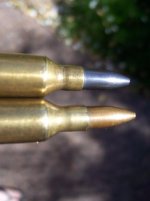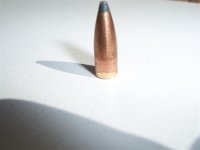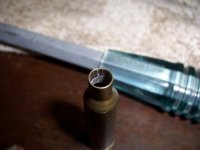Hi J,
I was looking for a little humor with my post but what I described actually is what I do. There are many procedures that we employ that we worry might be important, but we aren't sure which ones really are.
Begining about ten years ago, in my personal quest for long range precision in competition, I would do about twenty things to my ammo that I had read or heard were or probably were important. Over the intervening years I continue to cut back on that twenty in order to simplify my labor at the reloading bench. In spite of much simplification in ammo prep, and my diminished visual acuity behind the gun over that same period, my personal performance seems to continue to improve over time. I think that's because with greater experience, I make fewer mistakes behind the gun and this game is about minimizing the worst shot.
In terms of what seems most important for ammo prep, to me, a die and chamber that work together is the crucial beginning for everything that follows. Al has been very helpful to me on this front (and I'll bet to many others as well) with his ongoing reminders and regular drum beating as to this fact. You can't do good work without brass that works in your rifle. The chamber makes the brass and if you screw it up with the die all is lost.Thanks Al.
Then the next thing is to find the middle of my rifle's tune and put my ammo there to minimize ugly surprises when conditions shift before I go to the line. I shoot all the ammo in a box before any of it is reloaded so that powder residue build up, neck tension and any other issue related to the number of firings remains the same for each case in that group. I use the chamber of the rifle as a gage to full length size just enough that the bolt handle falls without any resistance. If a few cases cause the lugs to drag a little I'll massage those cases in the die with extra lube until the bolt will drop on that case. I weigh my powder charges to the nearest kernel of powder to minimize vertical resulting from velocity spread. If a bullet seats with noticebly different drag than the others it gets segregated to use as an early sighter. Donuts kill groups even when the bullet seats above them because varying constriction in the neck screws with gas flow out of the case and changes the pressure curve. The best way to avoid donuts is to not neck turn at all and have a chamber that works with your brass as it comes out of the box (this requires good brass) and a die that works with your chamber. To me, these things seem to matter.
I offer all of the above to put my observations about neck polishing in context with my current loading practices.
Case neck polishing is one of the things I don't do anymore. I can't find any evidence in my own shooting to support its importance with this one caviat. I shoot roomy neck clearance, about 1% of caliber passes the "that looks about right" test for me. Less neck clearance may produce different results.
For my most current example to support the case that polished necks probably don't matter, even after considerable storage, I shot the same ammo (loaded for about 12 hours) last August at the Piedmont 600 yd match as I did at this month's match (7 months later). The results were very similar and my judgement is that this ammo's performance was identical and close to flawless on both dates.
I've gotten excellent results from ammo that's been loaded for more than a decade. I do recognize that stressed brass moves over time but if the stress is the same for each case in question and the time is the same I imagine that the effect is the same among that group of cartridges and their bullets will fall into the same group.
That's my story and I'm stickin' to it.
Of course, as they say, YMMV.
Best regards and good shooting,
Greg




